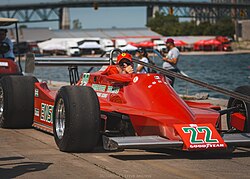 | |||||||||
| Category | Formula One | ||||||||
|---|---|---|---|---|---|---|---|---|---|
| Constructor | Team Ensign | ||||||||
| Designers | John Baldwin (Technical Director) Shahab Ahmed (Chief Designer) | ||||||||
| Predecessor | Ensign N177 | ||||||||
| Successor | Ensign N180 | ||||||||
| Technical specifications | |||||||||
| Chassis | Aluminium monocoque. | ||||||||
| Wheelbase | 2,667 mm (105.0 in) | ||||||||
| Engine | Ford-Cosworth DFV 2,993 cc (182.6 cu in) 90° V8, naturally aspirated, mid-mounted. | ||||||||
| Transmission | Hewland FGA 400 5-speed manual gearbox. | ||||||||
| Weight | 578 kg (1,274 lb) | ||||||||
| Fuel | Valvoline | ||||||||
| Tyres | Goodyear | ||||||||
| Competition history | |||||||||
| Notable entrants | Team Ensign | ||||||||
| Notable drivers | | ||||||||
| Debut | 1979 South African Grand Prix | ||||||||
| |||||||||
| Constructors' Championships | 0 | ||||||||
| Drivers' Championships | 0 | ||||||||
The Ensign N179 was a Formula One racing car designed by Dave Baldwin, and used by Team Ensign during the 1979 Formula One season. It was designed by John Baldwin and Shahab Ahmed. [1] [2]